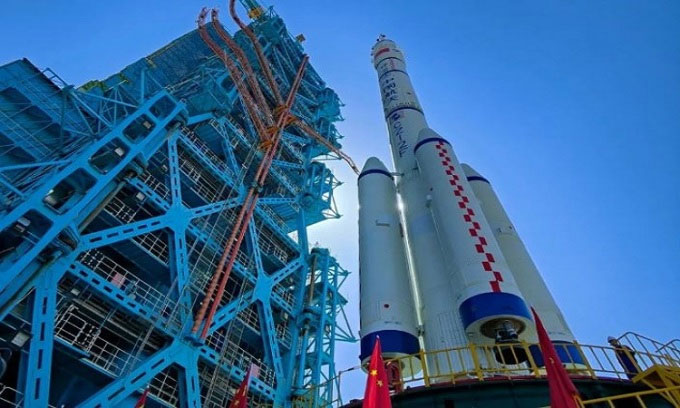The duo of spacecraft and rocket, standing 60 meters tall, will transport three astronauts to the core module of the Chinese space station, preparing for docking with a new module.

The rocket and spacecraft assembly near the launch tower. (Photo: CGTN)
The crewed Shenzhou 14 spacecraft mounted on the Long March 2F rocket was transported to the launch pad at the Jiuquan Satellite Launch Center in northwest China on May 29, according to the China Manned Space Engineering Office (CMSEO).
The Shenzhou 14 spacecraft will carry three astronauts to the Tianhe core module of the Tianhe space station in June for a six-month mission, according to Huang Weifen, chief designer of the astronaut system in China’s crewed space program.
This rocket and spacecraft duo weighs 39 tons and stands nearly 60 meters tall, slowly departing from the final assembly test building and moving towards the launch tower after traveling 1.5 kilometers along a specially constructed rail designed to minimize vibrations. After approximately 1.5 hours, the rocket and spacecraft approached the launch tower more closely, and the rotating platform closed.
All vehicles and equipment at the launch center are in good condition. Many functional checks and integration tests will be conducted as scheduled before the launch. Zhang Fusheng, chief designer of the crewed spacecraft system, stated that they will complete the final assembly process and all tests, including propellant fueling. They will also conduct large-scale system interface checks for the rocket system.
A total of six space missions will take place in 2022 to complete the construction of the Tianhe space station, forming a T-shaped configuration by October. Following the launch of the cargo spacecraft Tianzhou 4 in May and the crewed Shenzhou 14 in June, the Wentian experimental module will dock with the Tianhe core module in July, and the Mengtian experimental module in October. The Tianzhou 5 cargo spacecraft and Shenzhou 15 will then fly to the station, bringing three more astronauts to work at the station for six months. Additionally, China plans to launch the Xuntian Telescope (CSST) in 2023.


















































